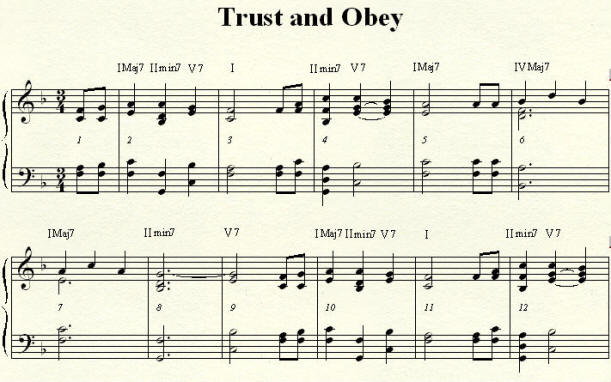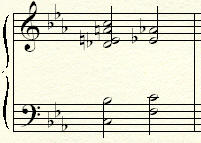Free Lessons
Secondary dominants
As we continue to work through “Trust and Obey”, I need to take a lesson to explain one particular chord in the song. It occurs in measure 19 and is labeled as a VI7 (dominant VI chord).


Before I start talking about this particular chord, I want to point out that the chord progressions in the rest of the song are very explainable. In fact, there are really only two progressions being used. They are IV-I and ii-V-I. Take a moment and see if I am not right.
Both of these progressions are based on the circle of fifths. They are basic progressions that you will find over and over in every hymn you play. Start watching for them. As strange as it sounds, you can build an infinite number of songs based just on a few simple progressions such as these, and in fact, that is what has happened during the history of Western music.
That being said, let’s talk about the dominant VI chord found in measure 19. As you know, a VI chord is typically minor. The V chord is the only chord that is naturally dominant. Here is a lesson to refresh you on this.

When you see a dominant chord other than V7, it is most likely a secondary dominant. There are five chords you will typically see that fall into this category–I7, II7, III7, VI7, and VII7. By the way, remember that a dominant chord is a major chord with a minor 7th added. See this chord cheat sheet if you need more information.
In traditional hymns, you rarely see chords outside of the key with the exception of secondary dominants and occasional diminished chords. Secondary dominants in particular are fairly common and we need to talk about them.
First of all, remember that a dominant chord usually resolves down a fifth, or sometimes a half step. The same is true for secondary dominants–in most cases, you will see them resolve down a fifth. In this example from measure 19 of “Trust and Obey”, the A7 (VI7) resolves down to ii7 (D minor 7). This by the way is why this chord is often referred to as a V of II.
Here is a chart with the secondary dominants you might see:
| VI7 | V of II | |
| VII7 | V of III | |
| I7 | V of IV | |
| II7 | V of V | |
| III7 | V of VI |
Here are some things you should know about using secondary dominants.
1) New chord substitutions: Change ii, iii, and vi to II, III, and VI. Very often, if a progression is moving with the circle of
fifths, you can change one of the normal minor chords to major (making it a secondary dominant). This will give you a different sound but will not affect the progression. Here are two examples of the first few measures of “At the Cross.” Note the Gmin7 chord in the 5th full measure is changed to a G7 chord in the
second example. This makes it a V of vi secondary dominant.


2) Changing a major 7th chord to dominant changes its function. Remember that there are two natural major 7th chords in every key–I and IV. I have never seen a IV7 chord that acted like a secondary dominant. I have, however, seen many I7 chords. Understand however, that there is a major difference between a IMaj7 and a I7. A IMaj7 does not need to resolve. However, a I7 will want to resolve down a fifth. That is why a I7 is often called a V of IV.
So, as a rule, changing a major 7th chord to a dominant chord is not a good idea unless you have a good reason.
3) Add a flat 9th to secondary dominants if resolving to a minor chord. This is a trick that my current teacher taught me. You will find that if you are playing a V of ii, V of iii, or V of vi, the flat 9th sounds great in the secondary dominant chord. There is a reason why, but I will skip the explanation for the moment. To hear this, go back to measure 19 in “Trust and Obey” and play a Eb with the thumb of your right hand. Here is another example of how it might sound–this is a V of ii – ii7 (C7 – Fmin7) progression.

Don’t worry too much if you do not understand everything I have written in this lesson. I just want you to be able to identify secondary dominants when you see them and understand where they probably are going to resolve. I will discuss the nuances of these chords in much more detail later.
Now that we have covered this, you should be able to look at the harmony for “Trust and Obey” and understand it. In fact, if I have succeeded, you are seeing this hymn in a whole new light.
Practice Strategy:
Go through a hymnal and analyze the chord progressions of a few hymns. Especially look for secondary dominants. Also, practice playing secondary dominants progressions in a few keys. Play V of ii to ii, V of iii to iii, etc.
